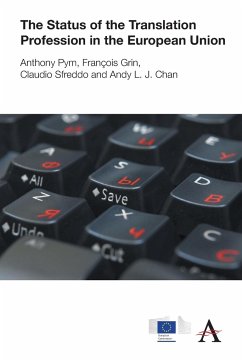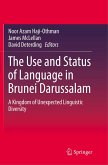Anthony Pym, Claudio Sfreddo, Andy L. J. Chan
The Status of the Translation Profession in the European Union
Anthony Pym, Claudio Sfreddo, Andy L. J. Chan
The Status of the Translation Profession in the European Union
- Broschiertes Buch
- Merkliste
- Auf die Merkliste
- Bewerten Bewerten
- Teilen
- Produkt teilen
- Produkterinnerung
- Produkterinnerung
This book examines in detail traditional status signals in the translation profession. It provides case studies of eight European and non-European countries, identifying a number of policy options and making recommendations on rectifying problem areas.
Andere Kunden interessierten sich auch für
![The Status of the Translation Profession in the European Union The Status of the Translation Profession in the European Union]() Anthony PymThe Status of the Translation Profession in the European Union101,99 €
Anthony PymThe Status of the Translation Profession in the European Union101,99 €![De-mystifying Translation De-mystifying Translation]() Lynne BowkerDe-mystifying Translation149,99 €
Lynne BowkerDe-mystifying Translation149,99 €![The Use and Status of Language in Brunei Darussalam The Use and Status of Language in Brunei Darussalam]() The Use and Status of Language in Brunei Darussalam76,99 €
The Use and Status of Language in Brunei Darussalam76,99 €![Status of female characters in the works of Prosper Kompaore Status of female characters in the works of Prosper Kompaore]() Sophie OuedraogoStatus of female characters in the works of Prosper Kompaore40,99 €
Sophie OuedraogoStatus of female characters in the works of Prosper Kompaore40,99 €![A Union of Diversity A Union of Diversity]() Peter. A KrausA Union of Diversity130,99 €
Peter. A KrausA Union of Diversity130,99 €![Le Couteau Dans le C¿ur Le Couteau Dans le C¿ur]() Ange Fabrice DibiLe Couteau Dans le C¿ur18,99 €
Ange Fabrice DibiLe Couteau Dans le C¿ur18,99 €![A Dangerous Profession A Dangerous Profession]() Frederick BuschA Dangerous Profession16,99 €
Frederick BuschA Dangerous Profession16,99 €-
-
-
This book examines in detail traditional status signals in the translation profession. It provides case studies of eight European and non-European countries, identifying a number of policy options and making recommendations on rectifying problem areas.
Produktdetails
- Produktdetails
- Verlag: Anthem Press
- Seitenzahl: 192
- Erscheinungstermin: 1. Dezember 2014
- Englisch
- Abmessung: 229mm x 152mm x 11mm
- Gewicht: 287g
- ISBN-13: 9781783083473
- ISBN-10: 1783083476
- Artikelnr.: 41372813
- Herstellerkennzeichnung
- Libri GmbH
- Europaallee 1
- 36244 Bad Hersfeld
- gpsr@libri.de
- Verlag: Anthem Press
- Seitenzahl: 192
- Erscheinungstermin: 1. Dezember 2014
- Englisch
- Abmessung: 229mm x 152mm x 11mm
- Gewicht: 287g
- ISBN-13: 9781783083473
- ISBN-10: 1783083476
- Artikelnr.: 41372813
- Herstellerkennzeichnung
- Libri GmbH
- Europaallee 1
- 36244 Bad Hersfeld
- gpsr@libri.de
Anthony Pym, François Grin, Claudio Sfreddo and Andy L. J. Chan
GENERAL INTRODUCTION; 1. METHODOLOGICAL ISSUES 1.1. What Do We Mean by
Status? 1.2. What Do We Mean by "Signalling" and "Asymmetric Information"?
1.3. What Do We Mean by "Certification", "Accreditation", and
"Authorisation"? 1.4. Data-Gathering Methodology; 2. RESULTS 2.1. What is
the Status of Translators in Official Categorisations? 2.2. What is the
Relative Status of Educational Qualifications and Training? 2.3. The Status
of Translators of Official Documents 2.4. The Role of Translator
Associations; 3. CASE STUDIES 3.1. Germany 3.2. Romania 3.3. Slovenia 3.4.
United Kingdom 3.5. Spain 3.6. United States 3.7. Canada 3.8. Australia; 4.
SOCIOLOGICAL MODELLING 4.1. Models of Professionalisation 4.2. The Changing
Role of Translator Associations 4.3. A Majority of Women - So What? 4.4. A
Profession of Part-Timers and Freelancers? 4.5. The Role of Employer Groups
4.6. Comparison between Translators and Computer Engineers as Emerging
Professions; 5. ECONOMIC MODELLING 5.1. Information on Rates of Pay 5.2.
Estimations of Earning Equations 5.3. Asymmetric Information, Signalling,
and Equilibrium on the Market for Translations; 6. POLICY OPTIONS FOR
ENHANCED SIGNALLING 6.1. Free Market or Controlled Entry? 6.2. One Signal
or Many? 6.3. Signalling as a Commodity or a Service? 6.4. Modes of
Possible Intervention; 7. Recommendations; APPENDIX A. Translator
Associations: Years of Foundation and Numbers of Members; APPENDIX B. Why
There Are About 333,000 Professional Translators and Interpreters in the
World; APPENDIX C. Online Translator-Client Contact Services: New Modes of
Signalling Status; APPENDIX D. Types and Use of Economic Perspectives on
Translation; APPENDIX E. Equilibrium on the Translation Market; NOTES;
REFERENCES; ACKNOWLEDGEMENTS; NOTES ON THE RESEARCH TEAM
Status? 1.2. What Do We Mean by "Signalling" and "Asymmetric Information"?
1.3. What Do We Mean by "Certification", "Accreditation", and
"Authorisation"? 1.4. Data-Gathering Methodology; 2. RESULTS 2.1. What is
the Status of Translators in Official Categorisations? 2.2. What is the
Relative Status of Educational Qualifications and Training? 2.3. The Status
of Translators of Official Documents 2.4. The Role of Translator
Associations; 3. CASE STUDIES 3.1. Germany 3.2. Romania 3.3. Slovenia 3.4.
United Kingdom 3.5. Spain 3.6. United States 3.7. Canada 3.8. Australia; 4.
SOCIOLOGICAL MODELLING 4.1. Models of Professionalisation 4.2. The Changing
Role of Translator Associations 4.3. A Majority of Women - So What? 4.4. A
Profession of Part-Timers and Freelancers? 4.5. The Role of Employer Groups
4.6. Comparison between Translators and Computer Engineers as Emerging
Professions; 5. ECONOMIC MODELLING 5.1. Information on Rates of Pay 5.2.
Estimations of Earning Equations 5.3. Asymmetric Information, Signalling,
and Equilibrium on the Market for Translations; 6. POLICY OPTIONS FOR
ENHANCED SIGNALLING 6.1. Free Market or Controlled Entry? 6.2. One Signal
or Many? 6.3. Signalling as a Commodity or a Service? 6.4. Modes of
Possible Intervention; 7. Recommendations; APPENDIX A. Translator
Associations: Years of Foundation and Numbers of Members; APPENDIX B. Why
There Are About 333,000 Professional Translators and Interpreters in the
World; APPENDIX C. Online Translator-Client Contact Services: New Modes of
Signalling Status; APPENDIX D. Types and Use of Economic Perspectives on
Translation; APPENDIX E. Equilibrium on the Translation Market; NOTES;
REFERENCES; ACKNOWLEDGEMENTS; NOTES ON THE RESEARCH TEAM
GENERAL INTRODUCTION; 1. METHODOLOGICAL ISSUES 1.1. What Do We Mean by
Status? 1.2. What Do We Mean by "Signalling" and "Asymmetric Information"?
1.3. What Do We Mean by "Certification", "Accreditation", and
"Authorisation"? 1.4. Data-Gathering Methodology; 2. RESULTS 2.1. What is
the Status of Translators in Official Categorisations? 2.2. What is the
Relative Status of Educational Qualifications and Training? 2.3. The Status
of Translators of Official Documents 2.4. The Role of Translator
Associations; 3. CASE STUDIES 3.1. Germany 3.2. Romania 3.3. Slovenia 3.4.
United Kingdom 3.5. Spain 3.6. United States 3.7. Canada 3.8. Australia; 4.
SOCIOLOGICAL MODELLING 4.1. Models of Professionalisation 4.2. The Changing
Role of Translator Associations 4.3. A Majority of Women - So What? 4.4. A
Profession of Part-Timers and Freelancers? 4.5. The Role of Employer Groups
4.6. Comparison between Translators and Computer Engineers as Emerging
Professions; 5. ECONOMIC MODELLING 5.1. Information on Rates of Pay 5.2.
Estimations of Earning Equations 5.3. Asymmetric Information, Signalling,
and Equilibrium on the Market for Translations; 6. POLICY OPTIONS FOR
ENHANCED SIGNALLING 6.1. Free Market or Controlled Entry? 6.2. One Signal
or Many? 6.3. Signalling as a Commodity or a Service? 6.4. Modes of
Possible Intervention; 7. Recommendations; APPENDIX A. Translator
Associations: Years of Foundation and Numbers of Members; APPENDIX B. Why
There Are About 333,000 Professional Translators and Interpreters in the
World; APPENDIX C. Online Translator-Client Contact Services: New Modes of
Signalling Status; APPENDIX D. Types and Use of Economic Perspectives on
Translation; APPENDIX E. Equilibrium on the Translation Market; NOTES;
REFERENCES; ACKNOWLEDGEMENTS; NOTES ON THE RESEARCH TEAM
Status? 1.2. What Do We Mean by "Signalling" and "Asymmetric Information"?
1.3. What Do We Mean by "Certification", "Accreditation", and
"Authorisation"? 1.4. Data-Gathering Methodology; 2. RESULTS 2.1. What is
the Status of Translators in Official Categorisations? 2.2. What is the
Relative Status of Educational Qualifications and Training? 2.3. The Status
of Translators of Official Documents 2.4. The Role of Translator
Associations; 3. CASE STUDIES 3.1. Germany 3.2. Romania 3.3. Slovenia 3.4.
United Kingdom 3.5. Spain 3.6. United States 3.7. Canada 3.8. Australia; 4.
SOCIOLOGICAL MODELLING 4.1. Models of Professionalisation 4.2. The Changing
Role of Translator Associations 4.3. A Majority of Women - So What? 4.4. A
Profession of Part-Timers and Freelancers? 4.5. The Role of Employer Groups
4.6. Comparison between Translators and Computer Engineers as Emerging
Professions; 5. ECONOMIC MODELLING 5.1. Information on Rates of Pay 5.2.
Estimations of Earning Equations 5.3. Asymmetric Information, Signalling,
and Equilibrium on the Market for Translations; 6. POLICY OPTIONS FOR
ENHANCED SIGNALLING 6.1. Free Market or Controlled Entry? 6.2. One Signal
or Many? 6.3. Signalling as a Commodity or a Service? 6.4. Modes of
Possible Intervention; 7. Recommendations; APPENDIX A. Translator
Associations: Years of Foundation and Numbers of Members; APPENDIX B. Why
There Are About 333,000 Professional Translators and Interpreters in the
World; APPENDIX C. Online Translator-Client Contact Services: New Modes of
Signalling Status; APPENDIX D. Types and Use of Economic Perspectives on
Translation; APPENDIX E. Equilibrium on the Translation Market; NOTES;
REFERENCES; ACKNOWLEDGEMENTS; NOTES ON THE RESEARCH TEAM









